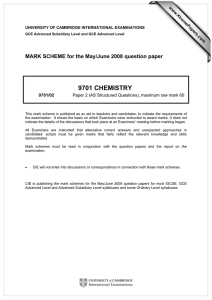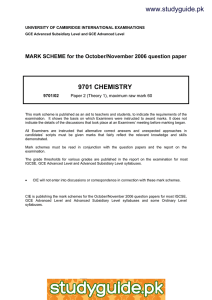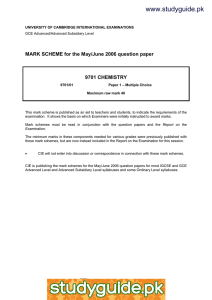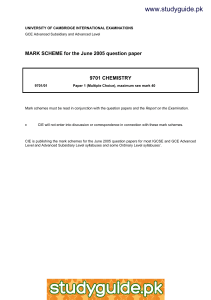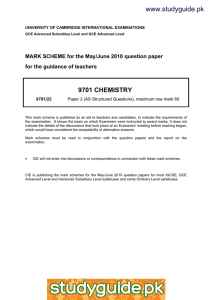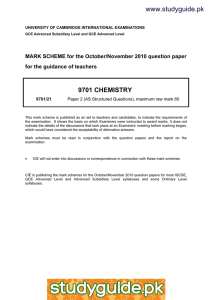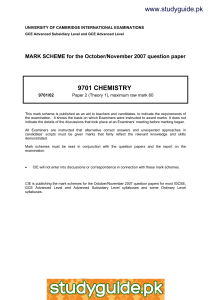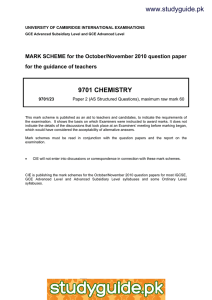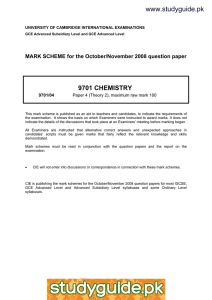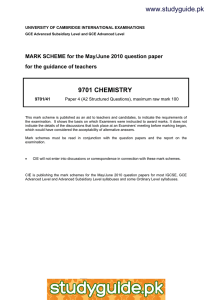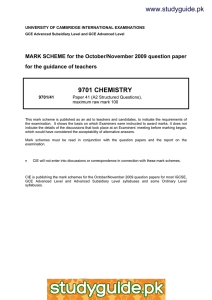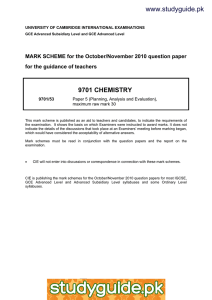www.studyguide.pk 9701 CHEMISTRY
advertisement
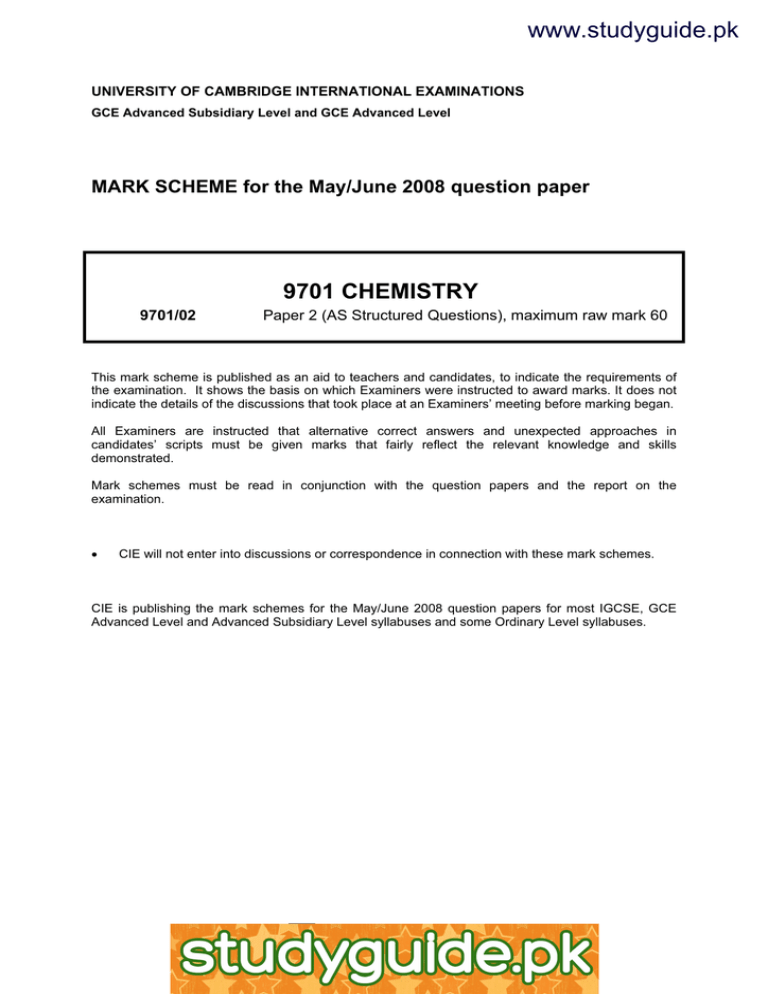
www.studyguide.pk UNIVERSITY OF CAMBRIDGE INTERNATIONAL EXAMINATIONS GCE Advanced Subsidiary Level and GCE Advanced Level MARK SCHEME for the May/June 2008 question paper 9701 CHEMISTRY 9701/02 Paper 2 (AS Structured Questions), maximum raw mark 60 This mark scheme is published as an aid to teachers and candidates, to indicate the requirements of the examination. It shows the basis on which Examiners were instructed to award marks. It does not indicate the details of the discussions that took place at an Examiners’ meeting before marking began. All Examiners are instructed that alternative correct answers and unexpected approaches in candidates’ scripts must be given marks that fairly reflect the relevant knowledge and skills demonstrated. Mark schemes must be read in conjunction with the question papers and the report on the examination. • CIE will not enter into discussions or correspondence in connection with these mark schemes. CIE is publishing the mark schemes for the May/June 2008 question papers for most IGCSE, GCE Advanced Level and Advanced Subsidiary Level syllabuses and some Ordinary Level syllabuses. www.xtremepapers.net www.studyguide.pk Page 2 1 Mark Scheme GCE A/AS LEVEL – May/June 2008 Syllabus 9701 Paper 02 (a) (i) 2 (1) (ii) between 104° and 105° (1) (b) ethanal [2] CH3CHO A (1) ethanol CH3CH2OH C (1) methoxymethane CH3OCH3 A (1) 2-methylpropane (CH3)2CHCH3 B (1) [4] (c) (i) hydrogen bonds (1) (ii) correct dipole on an -OH bond (1) hydrogen bond shown between the lone pair of an O and a H atom in an –OH group (1) lone pair on O atom of CH3OH or H2O clearly shown in the hydrogen bond (1) e.g. CH3 : O : LLHOH H or H : O : LLHOCH3 H [4] (d) hydrogen bonds exist between H2O molecules (1) hydrogen bonds cannot form between C2H5OC2H5 molecules (1) [2] [Total: 12] © UCLES 2008 www.xtremepapers.net www.studyguide.pk Page 3 2 Mark Scheme GCE A/AS LEVEL – May/June 2008 Syllabus 9701 Paper 02 (a) F(g) → F+(g) + e– correct equation (1) correct state symbols (1) [2] (b) from Na to Ar, electrons are added to the same shell/have same shielding (1) are subject to increasing nuclear charge/proton number (1) are closer to the nucleus or atom gets smaller (1) [3] (c) (i) Al and Mg in Al outermost electron is in 3p rather than 3s (1) 3p electron is at higher energy or is further away/is more shielded from nucleus (1) (ii) P and S for P 3p sub-shell is singly filled and for S one 3p orbital has paired electrons (1) paired electrons repel (1) [4] (d) (i) and (ii) Na Mg Al Si P S melting point low ------ high high low low conductivity high ------ high moderate low low (1) (1) (1) (1) element (1) one mark for each correct column [5] (e) because they had not been discovered (1) [1] [Total: 15] © UCLES 2008 www.xtremepapers.net www.studyguide.pk Page 4 3 Mark Scheme GCE A/AS LEVEL – May/June 2008 Syllabus 9701 Paper 02 (a) high temperature (and/or pressure) provide enough energy (1) to break N≡N bond or to provide Ea for N2/O2 reaction (1) [2] (b) (i) two from C, CO, hydrocarbon, SO2, H2S, NO2/NOx (1 + 1) not CO2, H2, H2O, SO3, NO (ii) Pt or Pd or Pt/Rh or Pt/Pd/Rh (1) (iii) 2NO + 2CO → 2CO2 + N2 or 2NO + C → CO2 + N2 (1) (c) (i) Kc = [NO]2 [Cl 2 ] [NOCl ]2 [4] (1) units are mol dm–3 (1) (ii) at 230 °C Kc = (1.46 × 10 −3 ) 2 × 1.15 × 10 −2 (2.33 × 10 −3 ) 2 = 4.5 × 10–3 mol dm–3 (1) at 465 °C Kc = (7.63 × 10 −3 ) 2 × 2.14 × 10 −4 (3.68 × 10 − 4 ) 2 = 9.2 × 10–2 mol dm–3 (1) allow ecf on answer to part (i) (iii) endothermic because Kc increases with temperature mark is for explanation allow ecf on answer to part (ii) (1) [5] (d) (i) equilibrium moves to RHS (1) more moles on RHS (1) (ii) no change to equilibrium position (1) [NOCl ] and [NO] change by same amount (1) [4] [Total: 15] © UCLES 2008 www.xtremepapers.net www.studyguide.pk Page 5 4 Mark Scheme GCE A/AS LEVEL – May/June 2008 Syllabus 9701 Paper 02 (a) (i) H H Br C C Br H H H Br H C C Br H H D E (1) (1) (ii) Br Br Br C=C C=C H H H H Br cis trans (1) (1) [4] (b) (i) hydrogen (1) nickel catalyst – allow platinum or palladium (1) (ii) isomer formed must be 1,2-dibromoethane (D above) because cis isomer has one Br atom on each carbon atom (1) mark is for the reason but wrong isomer is penalised [3] [Total: 7] © UCLES 2008 www.xtremepapers.net www.studyguide.pk Page 6 5 Mark Scheme GCE A/AS LEVEL – May/June 2008 Syllabus 9701 Paper 02 (a) (i) silver or black ppt. (1) (ii) O=C—C=O HO OH or HO2CCO2H (1) allow anion [2] (b) (i) NC CN HO—C—C—OH H H or NCCH(OH)CH(OH)CN (1) allow NCCH(OH)CHO (ii) nucleophilic addition (1) (iii) HO2C CO2H HO—C—C—OH H H or HO2CCH(OH)CH(OH)CO2H (1) allow HO2CCH(OH)CHO (ecf) [3] (c) (i) (ii) O=C—C=O HO OH or HO2CCO2H (1) H H HO—C—C—OH H H or HOH2CCH2OH (1) allow HOH2CCHO (iii) NaBH4 or LiAl H4 or H2/Ni (1) [3] (d) both oxidation and reduction allow disproportionation (1) [1] (e) HO—C≡C—OH – candidate’s compound must be C2H2O2 -OH present (1) C≡C present (1) [2] [Total: 11] © UCLES 2008 www.xtremepapers.net
